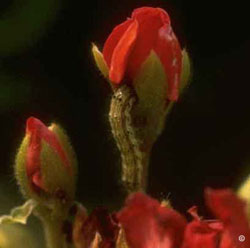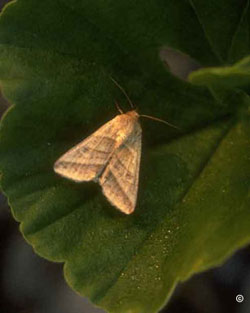
Tobacco budworm is a serious pest of geraniums, petunias and other garden flowers in Colorado. In several other areas of the country, people no longer grow geraniums or petunia because of damage caused by geranium budworm.
Budworm caterpillars attack buds of developing flowers. Damaged buds don’t open, and lack of flowering usually is the first injury observed. Flowers that do emerge appear ragged and have a chewed appearance. As insects feed through the summer, the damage increases and becomes even more noticeable.
The larval stage of the insect causes the damage. Larvae are marked with several stripes. The overall color of larvae varies from red to green or brown. Caterpillars become full grown in about one month and then drop to the ground to pupate. There are two generations per year.

The most effective way to manage tobacco budworm is to monitor plants for damage. Check buds and flowers for small holes, and hand-pick damaged flowers from small plantings. The best time to check for budworm is during dusk. That’s when larvae are most active.
Chemicals available to homeowners haven’t proven their effectiveness against tobacco budworm larvae. Certain varieties such as ivy geraniums are damaged less frequently than standard geranium types. Removing soil and repotting plants can be an effective management tool if plants are kept between seasons.
For more information, see the following Colorado State University Extension fact sheet(s).



